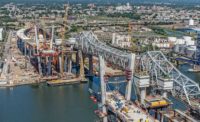Bond-Boosted Jersey Job Hits Halfway Mark

Aided by a presidential extension of Build America Bonds—and, somewhat ironically, by the recession—the $2.5-billion widening of the New Jersey Turnpike in the middle of the Garden State has reached its halfway point, with an average $1 million worth of construction occurring every day.
The 35-mile-long program includes widening the turnpike to 12 lanes from six, starting two miles south of Interchange 6 to the existing 10-lane roadway south of Interchange 8A. Then, a new lane is added in each direction until Interchange 9.
The widening is designed to handle an estimated 17.5% population growth between 2005 and 2032 in central New Jersey and increase traffic out of the state's ports. The program got a boost in 2009 when the New Jersey Turnpike Authority became the nation's first transportation agency to sell more than $1 billion in taxable bonds; the bonds came with a 35% reimbursement from the federal government under the American Recovery and Reinvestment Act (ENR 5/11/09 p. 10). The Build America Bonds (BABs) contributed $1.38 billion to the authority's $7-billion, 10-year capital program, as did $375 million in tax-exempt bonds.
In late 2010, as a federal extension to the BAB legislation neared its end, the turnpike sold more BABs for $1.85 billion, says Ronnie Hakim, the authority's executive director. Since the legislation stipulates that 80% of the money be spent in three years, officials wasted no time in preparing bid documents, acquiring permits and rights of way (ROW), and other preconstruction activities.
"We initially did preliminary engineering to get the layout for the widening program," says the turnpike's chief engineer, Richard J. Raczynski. "Normally, you'd go for permitting, then acquire ROW, then relocate utilities. That would have added three to four years on the project. We had to coordinate everything all at once."
The recession had a silver lining: Not only did all bids come in under the engineer's estimate—from 15% to 40%—but utility companies brought in contractors to do three major fuel pipeline relocations far more quickly than is typical, says Raczynski. "We came along with this program, and we got 10 to 12 bids on every contract."
Raczynski adds that tight margins and increased disputes or change orders were anticipated as a result. "We expected that when we saw the pricing coming and accounted for it in the project budget. Overall, we are under budget," he says.
All 28 contracts, ranging from reforestation to grading and drainage to paving and interchange ramps, have been awarded for the project, which is divided into eight design sections. HNTB Corp. serves as program manager overseeing design coordination.
"We had to decide how many contracts would be in each section," says Arthur A. Linfante Jr., HNTB project manager. "How would construction be staged from section to section? A great deal of thought went into it during the design process." HNTB coordinated with Stone & Webster, construction manager for a toll-plaza expansion at Interchange 7, and with a joint-venture CM team of GPI, AECOM and Parsons Brinckerhoff for the main line. HNTB is CM for Interchange 8. That interchange is being rebuilt on the other side of the turnpike in order to tie into a state route rather than emptying traffic into local town roads. Other major challenges include taking drainage off the roads and funneling it into huge new stormwater basins. The widening is set for completion in 2014.




